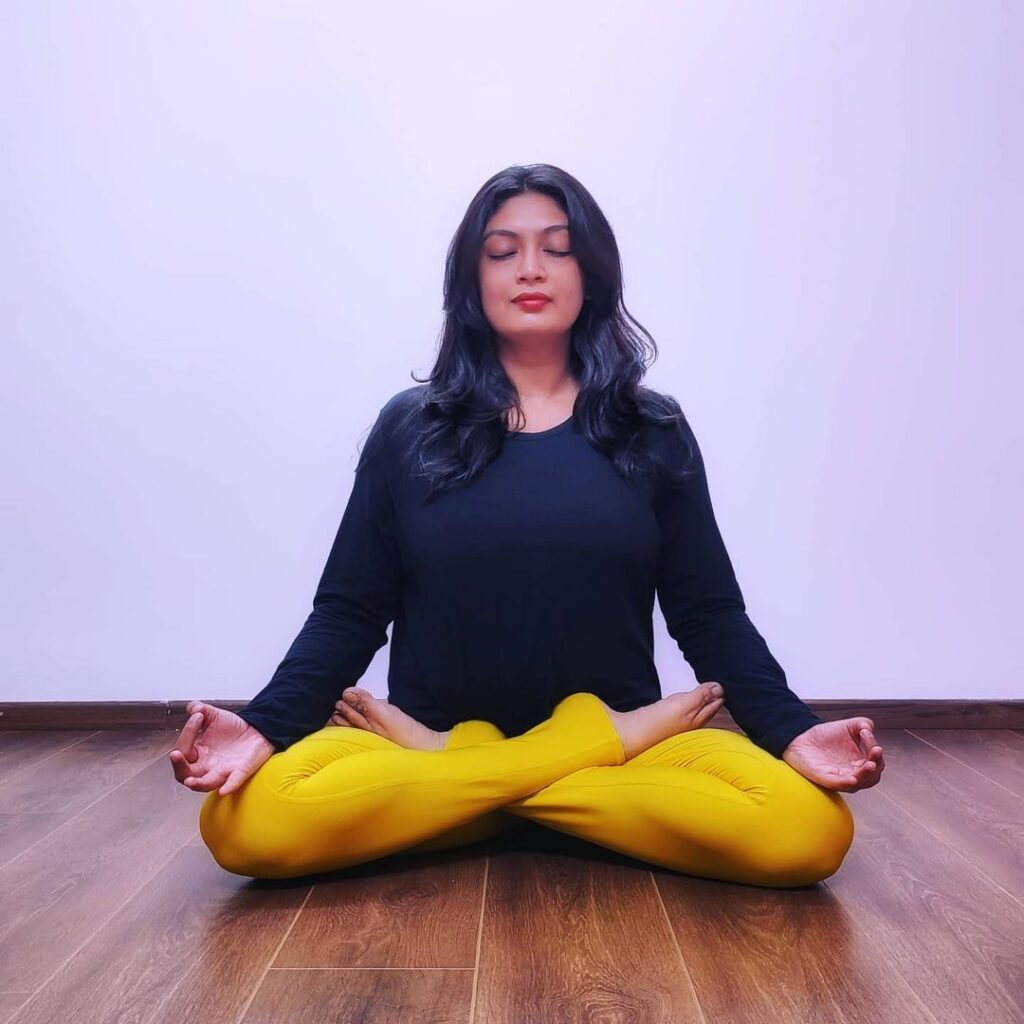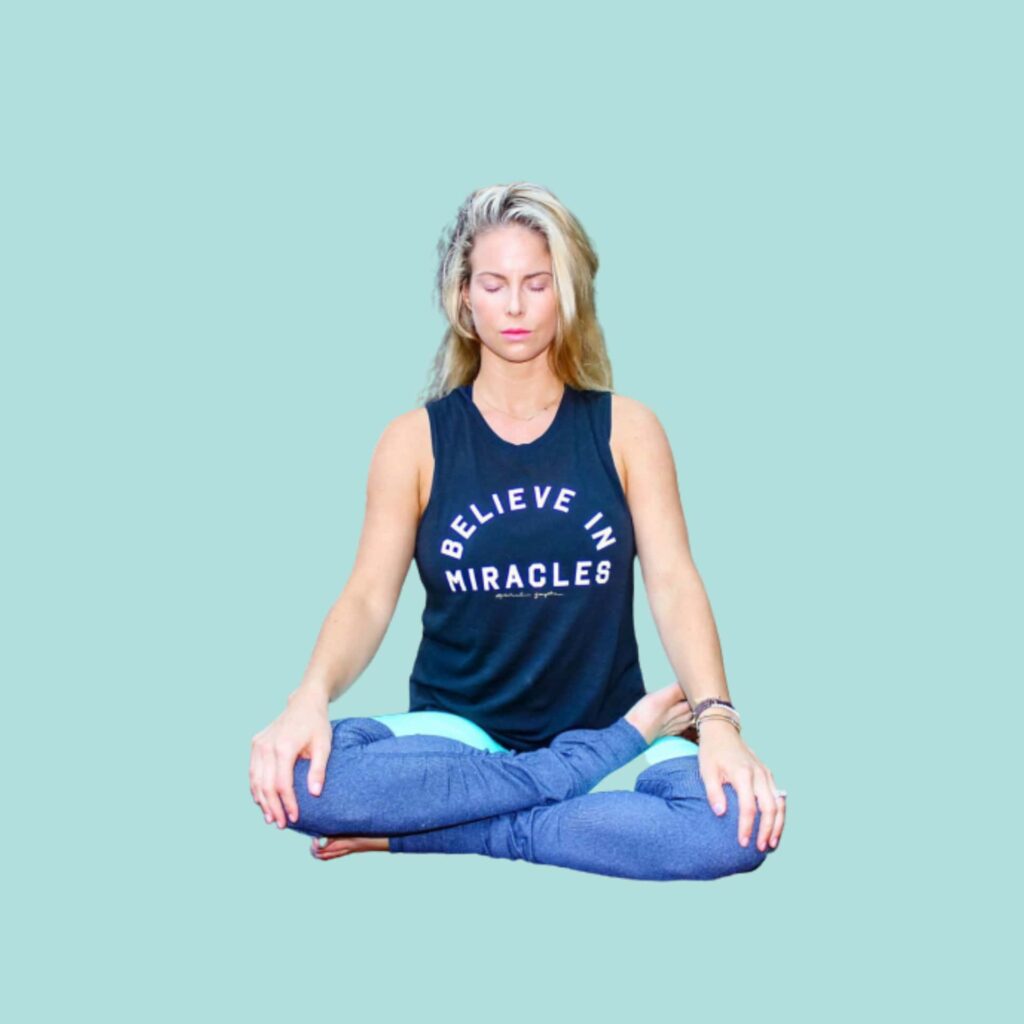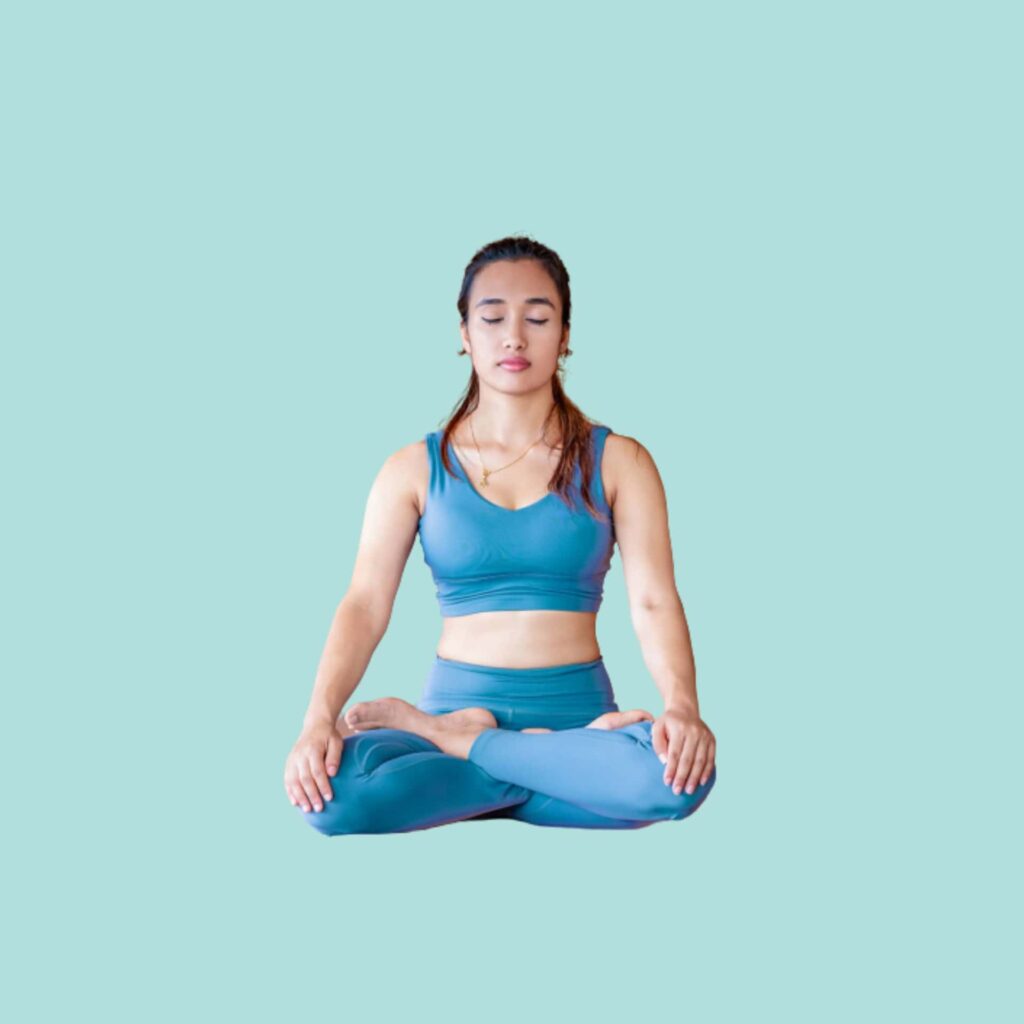Padmasana (lotus pose) is the classic and most famous meditation pose. If you can manage it, great. If you can’t, don’t sweat it.
Information
| Known as: | Padmasana, Lotus pose |
| Sanskrit name: | पद्मासन |
| IAST: | Padmāsana |
| Pronunciation: | pod-MAHS-anna |
| Level: | Intermediate/Advanced |
| Type: | Sitting, Hip opener, Meditation Pose |
| Style of yoga: | Hatha Yoga |
| Total time: | 1 to 5 minutes (10 to 15 minutes if meditating) |
| Drishti: | Forward; Eye closed |
| Chakra: | Sahasrara Chakra, Ajna Chakra, Swadisthana Chakra, Muladhara Chakra |
| Focus: | Legs, Ankle, Knee |
| Origin: | Ancient, Traditional |
| Indications: | Abdomen, Spine, Pelvis, Bladder |
| Counterposes: | Dandasana (Staff Pose), Gomukhasana (Cow Face Pose), Ardha Matsyendrasana (Half Lord of the Fishes Pose), Baddha Konasana (Bound Angle Pose), Uttanasana (Standing Forward Bend) |
| Preparatory poses: | Sukhasana (Easy Pose), Baddha Konasana (Bound Angle Pose), Janu Sirsasana (Head-to-Knee Forward Bend), Virasana (Hero Pose) |
| Follow-up poses: | Paschimottanasana (Seated Forward Bend), Bhujangasana (Cobra Pose), Adho Mukha Svanasana (Downward-Facing Dog Pose), Balasana (Child’s Pose) |
| Contraindications: | Low back, hip, knee, or ankle injury |
Meaning
Padmasana is a Sanskrit term that comes from two words – Padma + Asana:
- “Padma” = “lotus”
- “Asana” = “pose” or “posture” or “seat”
“Padma” means lotus, which is a flower symbolizing purity and spiritual awakening in many Eastern cultures. “Asana” means posture or seat, which refers to the physical pose itself. Therefore, Padmasana is a yoga posture or seat that resembles the shape of a lotus flower.
In this pose, the legs are crossed with the feet resting on opposite thighs, and the hands are placed on the knees or in a mudra (hand gesture) such as the chin mudra or jnana mudra. The spine is elongated, the shoulders are relaxed, and the eyes can be closed or gaze softly forward. Padmasana is often used for meditation and pranayama (breathing exercises) as it helps to stabilize the body and focus the mind.
Beyond its physical benefits, Padmasana is also considered a spiritual posture in some traditions, as it is said to activate the chakras (energy centers) in the body, and help awaken the Kundalini energy, which is believed to lie dormant
Padmasana (Lotus Pose) Practice Guide
Lotus Pose is one of the most advanced of the hip opening asanas. It is a continuation of Sukhasana (Easy Cross-legged Pose), in which the hips are flexed, abducted and externally rotated. The legs are brought to the thighs and a bandha is formed where the lower legs cross.
Getting to the Padmasana safely requires a lot of flexibility in the hips—especially in external rotations. This means that the muscles that internally rotate the hips must be brought out at full length. Conversely, if Lotus Pose is attempted with a tight internal rotator, the knees may suffer as the rotational forces of the pose pass to the knee, which must be maintained as a hinge. On the other hand, the hip is a ball and socket joint designed to rotate. Therefore, we must lengthen the tensor fascia latae and gluteus medius muscles (internal rotators) to transfer the rotational forces of this pose to the hips.
Instructions

Step-1
Extended with your feet (Dandana or Staff Currency) and increase your spine through Telbon through the crown of your head.
Step-2
Draw a heel for your navel, rotate your feet and feet, and place it above your feet above your thigh in the hip crease. Shin removes away from the chest.
Step-3
Drag your other heel to your navel, rotate your feet and feet, and place your opposite on the top of the thigh on the hip crease. Use your hands to expand the base of your pelvic floor; This is, rotate your thighs and hips, at one time, as you widen them on the edges. Drag your knees together and press your toonel in your thighs in your glow. Keep width in your pelvic floor because you root Telebon down and down so that the meat of buttocks has come back.
Step-4
Breathe deeply and expand your low stomach through the top of your head. Grow through the edges of your body, drag your shoulder back, and slide your shoulder blade below your back. Rest your breath and soften it in pause. Stay in this position from 1 to 15 minutes or as much as you want.
Step-by-step Anatomy Engaging Techniques
Step-1
- Flex your hips by engaging your posas muscles. The cue for this is to press your palms onto your knees and gradually try to lift up your hands. It gives a feel for activate your psoas.
- Ideally, your knee rests in an abducted position so that the contraction of your psoas is closed (the origin on your your pelvis and your lumbar spinal moves, instead of insertion on your femur).
- Consequently, your pelvis moves forward and your lumbar spine lift and extends.
- Your sartorius muscle, running from your anterior superior iliac spine to the inside of your knee, synergizes the tilt of your pelvis while helping to abduct and externally rotating your hip.
Step-2
- Engage your hamstrings in Padmasana. These are muscular stabilizers of your knees (with your quadriceps).
- Activating them in a pose such as Lotus Pose helps to maintain your joint congruency, so that your knee joint retains its hinge quality. This helps to protect your cartilage and ligaments.
- Pressing the ball of your foot forward can also be used to stabilize the knee joint, as this activates your gastrocnemius muscle, which by virtue of crossing your knee is also a muscular stabilizer.
Step-3
- Dorsiflex the foot at your ankle to hook it onto your thigh. Your tibialis anterior and your toe extensors activate to create this action.
- Slightly evert your ankle as well by contracting your peroneus longus and brevis muscles on the lower side of your leg. It helps to protect your ligaments on the outside of your ankle from overstretching.
- Then balance eversion with a slight inversion force by activating your tibialis posterior. Note how these muscles combine to dynamize your longitudinal foot arch.
- Repeat on your other leg.
Step-4
Tuck your tailbone under to engage the deep external hip rotators and the pubococcygeus muscle of your pelvic diaphragm. Activate your abductors at the sides of your hips—your gluteus medius and tensor fascia lata—to draw your thighs toward the floor.
Step-5
- Externally rotate your shoulders by engaging your infraspinatus and teres minor muscles of your rotator cuff. Your posterior deltoids synergize this action.
- Press your hands into the knees and rotate your hands outward to activate these muscles (imagine the motion of washing a window).
- Draw your shoulders away from your neck by contracting the lower third of your trapezius.
- Then adduct your scapulae toward the midline with your rhomboids.
- Hold your shoulders in this position to prepare for expanding your chest.
Step-6
With your scapulae stabilized toward the midline of your back, try to roll your shoulders forward. Your shoulders won’t move, but the force of the action will engage your pectoralis minor and lift your ribcage. Expand your chest out to the sides by contracting your serratus anterior muscles on the sides of your ribcage. Visualize pushing your hands into a door frame to feel these muscles contract.
Beginner’s Tip
This posture is famously hard to achieve for beginners and can cause pain on the legs, but if you are going to sit in meditation for long periods of time, it allows the highest level of stability and ease on the back.
Moreover, the posture is especially good at allowing the body’s prana, or subtle energy, to flow in a way that lends itself to deep and powerful meditative awareness.
Contraindications and Cautions
Please note that the Full Lotus pose can put too much strain on the knee joints.
Do not attempt this posture if you have weak or injured knees. Also avoid it if you have great difficulty achieving it, or if sitting in padmasana causes physical pain.
Before you attempt padmasana, it is good to practice other yoga positions that loosen the muscles and increase flexibility. If you suffer from sciatica, you should also avoid the lotus position.
Advanced practitioners who wish to sit in Full Lotus should work with a yoga instructor to help prepare them for this strenuous position.
Variations
In the variation called Half Lotus (Ardha Padmasana), one leg is drawn in and rests on the floor against the inside of the opposite thigh, while the other leg rests on top of the other thigh. This position is easier and requires less flexibility in the legs than the full lotus position.
Half Lotus is traditionally used during meditation and can be used when doing seated breathing exercises.
Instructions of half lotus pose (Ardha Padmasana)

- Sit with your spine comfortably extended and your shoulders down and away from your ears.
- Place the only of your right foot along the inside of your left thigh.
- Turn the top of your left foot so that it lies on the top of your right thigh. Be gentle with your knees and left ankle joint.
- Use a folded blanket or cushion to elevate your hips above the knees.
Benefits of Padmasana (lotus pose)
Padmasana is the best posture for meditation. The lotus pose or Padmasana allows for stability during long periods of sitting meditation. This posture not only allows a steady, sitting position without movement, it also encourages the mind to naturally calm down and rest in meditative awareness. It is helpful in concentration of mind and Pranotthana or Kundalini awaking. It Intensifies gastritis. Lotus pose is beneficial in Rheumatism (vātavyādhi).
However, the physical and mental benefits of this yoga pose are listed below:
- Physical Benefits:
- Increases knee flexibility and lubricates the knee joints
- Opens the hips
- Prevents arthritis and osteoporosis
- Promotes proper digestive system functions
- Tones abdominal organs
- Mental Benefits:
- Brings mental clarity
- Focuses the mind
- Reduces stress
The science behind the Lotus pose
Whenever you feel anxious and uncertain, without hesitation, descend into Padmasana. It is sure for you. They say that you will immediately feel the root of your female and settling in your waist. You will feel your energy rising, and as it happens, you will feel a light pass through your midline, almost grounding you.
This asana is a power-packed hip and heart opener, with many physical and spiritual benefits. This is one of the best attention poses. In this posture, the arrangement of your feet looks like beautiful lotus petals. This is metaphorical because the way lotus blooms with mud, similarly your earthly life represents dirt and mud. But when you practice yoga, and especially this asana, you have the ability to blossom into a beautiful flower – living every moment. The lotus pose works beautifully on many chakras, helping them to balance and stay awake.















